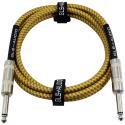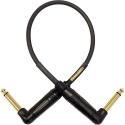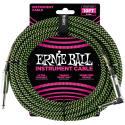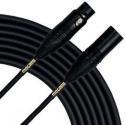TRS vs TS Cable - Why TRS is More Versatile
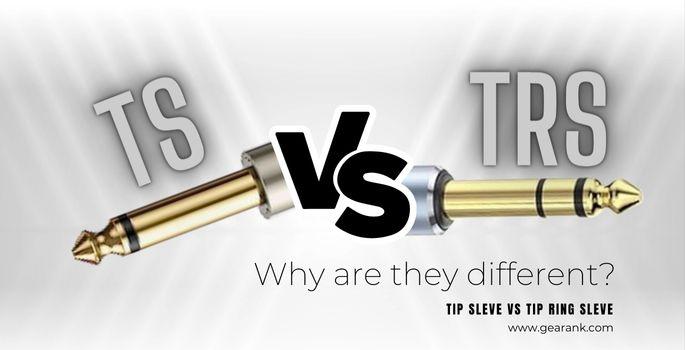
TRS vs TS CableTS cables are used for mono, unbalanced signals, like those with electric guitars. They have one conductor and a ground wire. TRS cables manage both mono and balanced signals, seen in audio interfaces, as well as stereo signals. Balanced cables, with two conductors and a ground wire, effectively reduce noise in audio signals. |
Working with live music means working with many different pieces of equipment. This means a lot of cables - and it's so easy to mix them up and forget what cable goes where.
It certainly doesn't help when the cables have similar names - just like with TRS and TS cables. So, what's the difference, and when should you use which cable?
If you keep confusing your TRS with TS cables, then don't worry. This guide will help you understand the differences to determine which cable works best in certain setup positions.
TS Vs TRS: Defining The Cables
First, let's define what both a TRS and TS cable is. Then, we can compare the two to see what cables work best in your setup.
What Is A TS Cable?
This is commonly known as a guitar cable, and is sometimes called a mono cable - but technically it is a TS cable.
The TS in the TS cables' name stands for its two contact points. These are:
-
T for Tip - This connects with the signal wire to send audio signals. This means that the tip is the conductor of audio signals.
-
S for Sleeve - The sleeve connects with the ground wire, preventing interference from interfering with the signals passing through the cable.
TS cables are often called guitar cables because they connect electric guitars and related equipment. This includes things like guitar effects patch cables and amp A/B boxes.
However, you can also use TS cables with TS cable connectors to connect to other electronic instruments like keyboards.
The role of a TS cable is to send audio cables to other equipment like mixers, receivers, or even other instruments.
TS cables are also sometimes called mono cables. This is because they send mono unbalanced signals through the cable that is sent directly to the equipment.
What Is A TRS Cable?
A TRS cable is another cable often used to connect pro audio gear.
The letters in its name also refer to the jack plug's three essential parts. They are:
-
T for Tip - Like with TS cables, an audio signal passes through the tip of the TRS cable jack plug.
-
R for Ring - This is another internal conductor, like the jack tip. It is used for balanced signals and stereo signals.
-
S for Sleeve - Like with a TS table, the sleeve connects with the ground wire. This is to reduce audio interference.
These three critical parts of the TRS cable each connect to different conductors. This means that TRS cables have three conductors used to transmit balanced audio or stereo signals. This is the reason why they are also called balanced cables.
TS Vs TRS Cables Comparison
Now you understand the key features and role of both a TS and TRS cable, it's time to compare TS vs TRS cables.
Number Of Conductors
The apparent difference between TRS cables and TS cables is that TRS cables have an additional conductor on the jack. This is reflected in the names of the cables. TRS stands for "Tip Ring Sleeve" - so the extra letter stands for the additional conductor.
The number of cable conductors also greatly affects how TS and TRS cables are used.
Mono Vs Stereo
TS cables only have one signal wire, meaning they can only send a single audio signal, or an unbalanced signal, or a mono signal. This is why TS cables are used as mono cables.
TRS cables, however, have two signal wires. This means they can send two audio signals simultaneously. This makes them capable of transmitting stereo audio. So, TRS cables are also stereo cables.
The reason why TS cables are mono, and TRS cables are stereo comes down to the number of signal conductors.
Adding an extra ring means TRS connectors can transmit a stereo signal. the two conductors can carry left and right audio channels. A TS connector only has one audio connector - so both left and right audio channels are transmitted through the same conductor.
However, TRS connectors can also transmit mono signals. They are typically used when a balanced mono signal is required.
Balanced Vs Unbalanced Signals
A balanced signal usually results from having two identical signals but opposite in phase. This requires a cable with two conductors and ground, such as an XLR cable or a TRS cable. When using a TRS cable for balanced signals, the additional conductor takes a copy of the signal with the opposite polarity. This means that when you connect gear with a balanced TRS input or output, the other signal is reversed in phase, and the noise gets canceled.
Balanced audio signals are typically used in pro audio gear and studio gear. Many types of audio interface use balanced outputs to send audio to studio monitors.
TS cables are classed as unbalanced. This is because the audio signal they carry is sent directly to the equipment it is input into. As a result, they can only carry unbalanced audio signals through their cable.
Because of this, TS cables tend to suffer more from distortion and noise interference.
TRS cables can produce cleaner music and audio than TS cables, especially for pro audio gear. This is because TS cables are unbalanced cables that carry an unbalanced audio signal. Meanwhile, balanced TRS cables can be used with balanced outputs typical of professional audio equipment like studio monitors and audio interfaces.
What About A TRRS Cable?
So, those are the differences between TRS and TS cables - but what about TRRS cables?
This third cable connector type has an additional ring on the jack, hence the extra R in its name. It serves the same purpose as the ring on TRS connectors - it balances the signal and prevents interference. It also carries stereo signals, and duplicates of the same signal.
They also allow extra channels so you can use more multimedia devices. As a result, they're often used as connectors for smartphones and computers. Check the jack on your headphones - they will likely use this type of jack.
TRRS cables are barely used in studio. If you need to transmit a balanced audio signal or a stereo signal, a TRS cable will suffice.
TS Vs TRS Cables: Final Thoughts
To summarize, TRS and TS cables are very different. TRS stands for Tip Ring Sleeve and TS stands for Tip Sleeve.
A TS cable carries mono and unbalanced signals. However, A TRS cable can function as a stereo or balanced cable. With a balanced signal, audio can pass through without noise interference.
When comparing TS (Tip-Sleeve) and TRS (Tip-Ring-Sleeve) audio plugs, understanding the concept of line level is crucial, as these plugs play a significant role in maintaining the integrity of signals at line level, ensuring optimal audio quality and compatibility in various audio devices.
If you have an audio interface that you want to connect to studio speakers, or a piece of outboard gear with 1 plug for a stereo output, then it pays to know the difference between TS Cables and TRS Cables.



